八年级英语第六单元教师讲学稿
- 格式:doc
- 大小:156.00 KB
- 文档页数:12
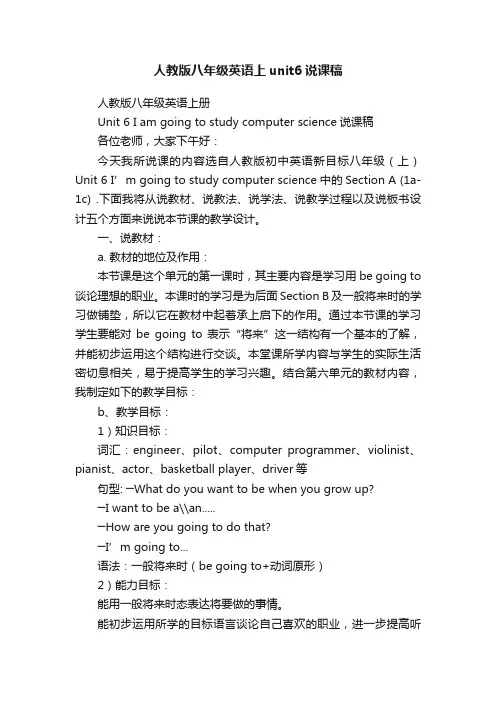
人教版八年级英语上unit6说课稿人教版八年级英语上册Unit 6 I am going to study computer science说课稿各位老师,大家下午好:今天我所说课的内容选自人教版初中英语新目标八年级(上)Unit 6 I’m going to study computer science中的Section A (1a-1c) .下面我将从说教材、说教法、说学法、说教学过程以及说板书设计五个方面来说说本节课的教学设计。
一、说教材:a. 教材的地位及作用:本节课是这个单元的第一课时,其主要内容是学习用be going to 谈论理想的职业。
本课时的学习是为后面Section B及一般将来时的学习做铺垫,所以它在教材中起着承上启下的作用。
通过本节课的学习学生要能对be going to表示“将来”这一结构有一个基本的了解,并能初步运用这个结构进行交谈。
本堂课所学内容与学生的实际生活密切息相关,易于提高学生的学习兴趣。
结合第六单元的教材内容,我制定如下的教学目标:b、教学目标:1)知识目标:词汇:engineer、pilot、computer programmer、violinist、pianist、actor、basketball player、driver等句型: ─What do you want to be when you grow up?─I want to be a\\an.....─How are you going to do that?─I’m going to...语法:一般将来时(be going to+动词原形)2)能力目标:能用一般将来时态表达将要做的事情。
能初步运用所学的目标语言谈论自己喜欢的职业,进一步提高听说读写的能力3)情感目标:本节课通过对职业的谈论和学习,让学生有一个自己的目标和计划,并对能他们的梦想有个积极的态度。
c、教学重、难点:1)重点:掌握本节课中表示职业的新词汇和句型,学生根据自己喜欢的职业,运用所学知识谈论自己打算怎样做来实现目标一般将来时中be going to的用法2) 难点:一般将来时be going to 中be 的具体形式和后面接动词原形的用法学生容易混淆.二、说教法为了顺利地完成教学目标,更好地突出重点、突破难点,我重点采用任务型教学法,听说法,将布置任务进行小组交流活动贯穿整堂课。
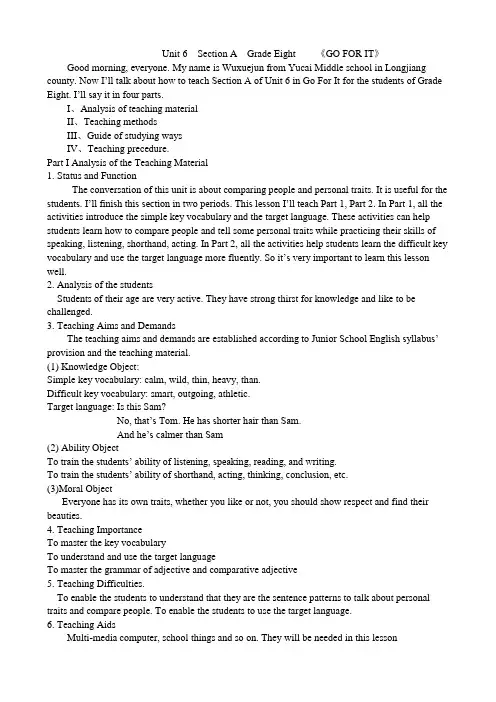
Unit 6 Section A Grade Eight 《GO FOR IT》Good morning, everyone. My name is Wuxuejun from Yucai Middle school in Longjiang county. Now I’ll talk about how to teach Section A of Unit 6 in Go For It for the students of Grade Eight. I’ll say it in four parts.I、Analysis of teaching materialII、Teaching methodsIII、Guide of studying waysIV、Teaching precedure.Part I Analysis of the Teaching Material1. Status and FunctionThe conversation of this unit is about comparing people and personal traits. It is useful for the students. I’ll finish this section in two periods. This lesson I’ll teach Part 1, Part 2. In Part 1, all the activities introduce the simple key vocabulary and the target language. These activities can help students learn how to compare people and tell some personal traits while practicing their skills of speaking, listening, shorthand, acting. In Part 2, all the activities help students learn the difficult key vocabulary and use the target language more fluently. So it’s very important to learn this lesson well.2. Analysis of the studentsStudents of their age are very active. They have strong thirst for knowledge and like to be challenged.3. Teaching Aims and DemandsThe teaching aims and demands are established according to Junior School English syllabus’ provision and the teaching material.(1) Knowledge Object:Simple key vocabulary: calm, wild, thin, heavy, than.Difficult key vocabulary: smart, outgoing, athletic.Target language: Is this Sam?No, that’s Tom. He has shorter hair than Sam.And he’s calmer than Sam(2) Ability ObjectTo train the students’ ability of listening, speaking, reading, and writing.To train the students’ ability of shorthand, acting, thinking, conclusion, etc.(3)Moral ObjectEveryone has its own traits, whether you like or not, you should show respect and find their beauties.4. Teaching ImportanceTo master the key vocabularyTo understand and use the target languageTo master the grammar of adjective and comparative adjective5. Teaching Difficulties.To enable the students to understand that they are the sentence patterns to talk about personal traits and compare people. To enable the students to use the target language.6. Teaching AidsMulti-media computer, school things and so on. They will be needed in this lessonPart II The Teaching Methods1. Communicative teaching method2. Audio-visual teaching method3.”Task-based”teaching methodAs we all know: the main instructional aims of learning English in the Middle School is to cultivate students’ abilities of listening, speaking, reading, writing and their good sense of the English language. So in this lesson I’ll mainly use “Communicative” teaching method,”Audio-visual” teaching method and “Task-base d” teaching method.That is to say, I’ll let the students to get a better understanding of the target language, master the vocabulary and grammar better. I’ll give the students some tasks and arrange several kinds of activities: watching pictures, writing, listening, making conversations, acting, group work and so onTeaching special features: To use these methods is helpful to interest students and develop their thoughts.Part III Studying ways1. Let the students master the key vocabulary better by guessing, acting, listening, using.2. Enable the students study English language by Communicating, Describing, Listening.3. Let the students understand the grammar well by summarizing the grammar rules by themselves. Part IV Teaching ProcedureStep 1 Warm up:Show a picture of Yaoming and a picture of a man, and say Yaoming is taller than him. Then give another picture, let them find the differences. While the student want to express their thought in English ,and they do not have learned the expressions, raise their desire for learning this part of knowledge.(purpose: To attract the student s’ attention and to create a relaxed atmosphere.)Then, show the students the goals :1.We must master the words in section A.2. We can use the adjective and comparative adjective to describe a person.Step2.Check oneLet the studengts do 1a. Practise the target language with long hair and tall. Students are allowed to speak slowly at the first time and a little faster at the second time.This part, I give the student the chance to practice the target language. Improve their speaking skills with comparative adjective.(Purpose: To begin with the review of adjective can enable the students easily master the key points including its regular information and irregular one as well as to learn to make statements by choosing the right adjectives.)Step3. Practice listening 1b—2bListen to the tape, and shorthand the key words. Then, write down the main information in the form of using the target language according to their own shorthand notes. When all have done with the work, I’ll give them the correct answers. And once again I will tell them the skills of shorthand. As shorthand is a useful skill in listening comprehension and modern society, students can learn and practise it from now on.(Purpose: In order to improve students’ listening and writing skills,by playing the recording of the text and repeating,students can further consolidate what they have just learned.)Step4.Performance and communicationDeskmates make a group. Let them act the dialogue with the information in the chart on page 81.Acting makes students understand the meaning of the key vocabulary better and attract the whole class. Making a conversation while some are acting, gives the student the chance to communicate with each other. Repeating the dialogues not only helps the rest of students’ discipline but also makes them practice the target language as well. Grading their own performance is a new way and will make the students try their best to perform well.(Purpose: Through comparison of description of parnter’s appearance and personality can easily arouse students’ learning desire and interests. So they can master difficulties and key points of the text and describe others well.)Step5 ConsolidationDiscuss the two people in the picture. Which one do you like better? why? Then, gradually let them understand we should respect everyone, because every one has its good merits and shortcoming. We should find people’s beauties not only look at their short comings. Good teachers teach not only the students knowledge, but also how to be a man and behave.Write the 3 lists of adjective and comparative adjective are on the blackboard, let one in each group summary the regualaries.It comes to grammar teaching. This part, students are trained to use their own wit to summarize some principles. It is designed to gain points, and students’ wit is cha llenged, so this activity willra ise the students’ interest.Step 6 Check TwoCover the blackboard for 30seconds, and let the students close their eyes and review what they have just learnt. Make a better use of the difficulties and important information on the blackboard. Reviewing at the end of the class can help students’ memory, This part also practice the reading ability and check the pronunciation.Step7 Homework .Make a list of top 10 obvious traits or comparison about your best friend or your parents. When it comes to the homework part, teachers should have enough time to explain their assignment clearly to avoid misunderstanding of demands. At the meantime, the teacher can give students some advice to finish their homework efficiently. Homework which is related to the students’ life can surely trigger their interest to finish the homework earnestly. The homework can help the students to consolidate the target language and train their writing ability.(Purpose: it’s necessary for students to do some extensive exercise after class to consolidate the knowledge they learnt.)Step 8 Blackboard designUnit 6 I’m more outgoing than my sister-er -ier more ~ -Is that Sam?calm-calmer funny-funnier athletic-more athletic -No, that’s Tom, he has shorter hairtall-taller heavy-heavier outgoing-more outgoing than Sam. And he’s calmer than Sam smart-smarter happy-happier interesting-more interestingwild-wilder thin-thinner。
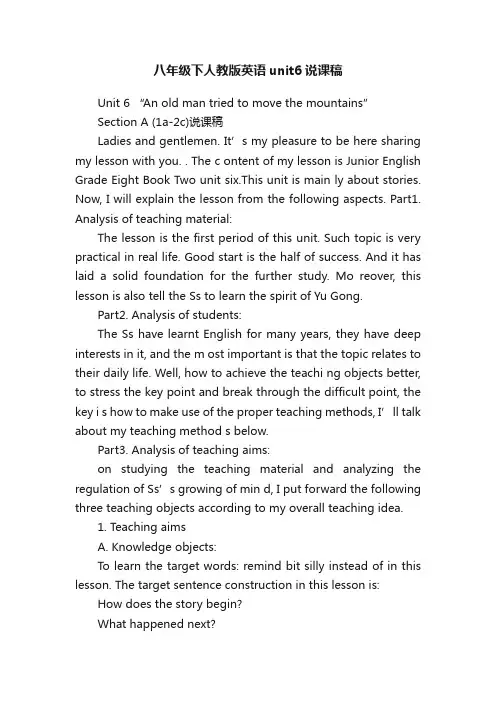
八年级下人教版英语unit6说课稿Unit 6 “An old man tried to move the mountains”Section A (1a-2c)说课稿Ladies and gentlemen. It’s my pleasure to be here sharing my lesson with you. . The c ontent of my lesson is Junior English Grade Eight Book Two unit six.This unit is main ly about stories. Now, I will explain the lesson from the following aspects. Part1. Analysis of teaching material:The lesson is the first period of this unit. Such topic is very practical in real life. Good start is the half of success. And it has laid a solid foundation for the further study. Mo reover, this lesson is also tell the Ss to learn the spirit of Yu Gong.Part2. Analysis of students:The Ss have learnt English for many years, they have deep interests in it, and the m ost important is that the topic relates to their daily life. Well, how to achieve the teachi ng objects better, to stress the key point and break through the difficult point, the key i s how to make use of the proper teaching methods, I’ll talk about my teaching method s below.Part3. Analysis of teaching aims:on studying the teaching material and analyzing the re gulation of Ss’s growing of min d, I put forward the following three teaching objects according to my overall teaching idea.1. Teaching aimsA. Knowledge objects:To learn the target words: remind bit silly instead of in this lesson. The target sentence construction in this lesson is: How does the story begin?What happened next?What do you think of the story of Yu Gong?What could Yu Gong do instead of moving the mountains?B. Ability objects:(1).To develop the students’ abilities of listening,(2).To t rain the students’ ability of working in pairs and groups.(3).To develop the students’ ability of communication by learning the useful structures.C. Emotion objects:To train the students to learn the spirit of Yu Gong.Part4. Teaching method:According to the modern perception theories and social intercourse teaching theori es. I adopt the Total Situational Action and Task-based Language Teaching.At the same time, make use of all kinds of teaching means, such as ppt, flash-cards …it can mobilize the Ss’ enthusiasm and creativity in learning English.Part 5. Teaching proceduresAs to teaching procedures, I designed the following steps to achieve my teaching aim s. They are “ Lead-in ,presentation ,reading task, home work ,blackboard design.”Step One: Lead-in3. Teaching ProceduresI’ll finish this lesson in 7 steps.Step 1 Lead in1. Let the Ss watch the flash “Yu Gong Moves a Mountain” to lead the topic of the Unit. I will ask the questions like this: T: What’s the name of the story?S1:It’s Yu Gong move s a mountain.S2: It’s a traditional Chinese story.T: Do you know other traditional Chinese stories?… …Step 2 PresentationLead the Ss to read the new words and phrases and then the Ss try to remember them. Step 3 Writing1. Look at the pictures in 1a, and then read the names of the story in the box.2. Ss discuss with their partners and match the names of the stories with the pictures. Step 4 Listening1. T: Tell Ss they will hear a great Chinese traditional story. Listen and see who know the name of the story.2. Play the recording for the Ss to listen.3. Ss who know the name of the story may hand up.4. Play the recording again. Let Ss check the facts they hear.5. Check the answers.Step 5 Pair work1. Read the questions in the box in 1c.2. Ss discuss the questions with their partners.3. Let some pairs ask and answer the questions.e.g. A: How does the story happen?B: There were two very tall mountains in front of their house.A: What happened next?B: A very old man tried to move the mountains.A: Where would they put all the earth and stone from the mountains?B: They would put them into the sea.Step 6 ListeningWork on 2a:1. Look at the pictures in 2a. Discuss the things they are going to do. When you listen to the story, please number thepictures.2. Play the recording for the Ss to listen and number the pictures.3. Play the recording again to check the answers.Work on 2b:1. Let Ss read the sentences below. Explain some main sentences for the Ss. Make sure they know what to do.2. Play the recording for the Ss to circle the correct words in the brackets.3. Play the recording again to check the answers.Step 7 Group work1. Tell Ss to make a story chain. Ss tell the story one by one with the pictures in 2a.2. Let some Ss tell the story to the class.Step 8 HomeworkTell the story Yu Gong Moves a Mountain in English to your parents.Once upon a time, there was a very old man…Step 8: Design of blackboardTo be a good teacher is my dream. I think a teacher is not only a guide for the Ss bu t also a friend of them. So I’d like to build close relationship with my Ss. Helping the m not only on their study but also on their life. In order to make our English classroo ms shine with vitality, we are laid with heavy burden, and we still have a long way to go.“An old man tried to move the mountains”Section A (1a-2c)说课稿濮阳油田实验学校八年级英语组冯漫利2015年4月。
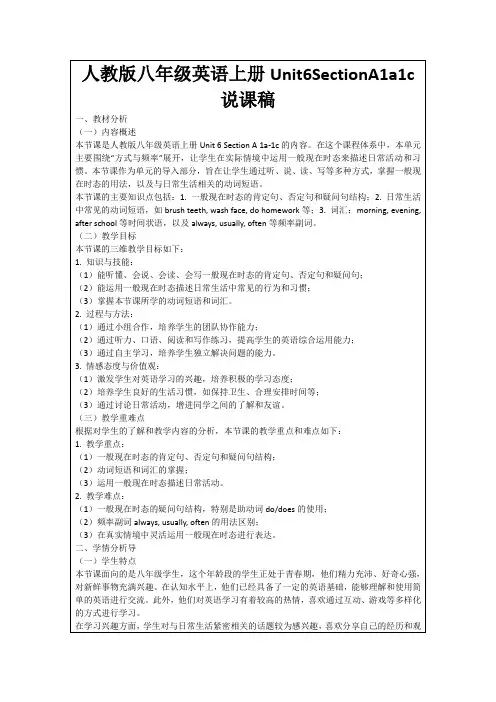
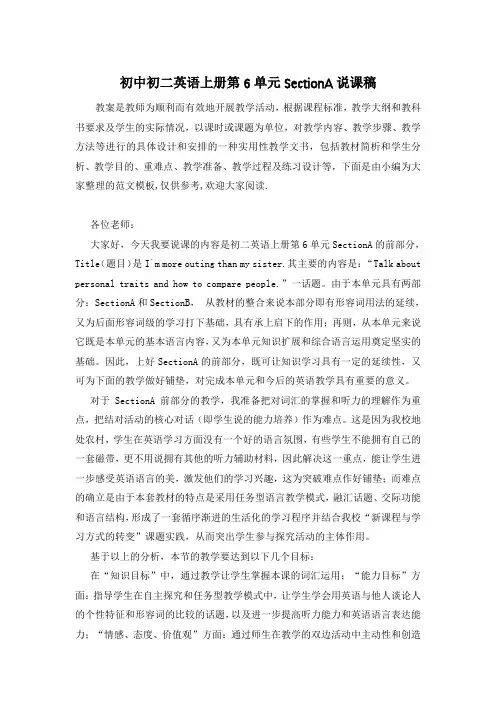
初中初二英语上册第6单元SectionA说课稿教案是教师为顺利而有效地开展教学活动,根据课程标准,教学大纲和教科书要求及学生的实际情况,以课时或课题为单位,对教学内容、教学步骤、教学方法等进行的具体设计和安排的一种实用性教学文书,包括教材简析和学生分析、教学目的、重难点、教学准备、教学过程及练习设计等,下面是由小编为大家整理的范文模板,仅供参考,欢迎大家阅读.各位老师:大家好,今天我要说课的内容是初二英语上册第6单元SectionA的前部分,Title(题目)是I`m more outing than my sister.其主要的内容是:“Talk about personal traits and how to compare people.”一话题。
由于本单元具有两部分:SectionA和SectionB,从教材的整合来说本部分即有形容词用法的延续,又为后面形容词级的学习打下基础,具有承上启下的作用;再则,从本单元来说它既是本单元的基本语言内容,又为本单元知识扩展和综合语言运用奠定坚实的基础。
因此,上好SectionA的前部分,既可让知识学习具有一定的延续性,又可为下面的教学做好铺垫,对完成本单元和今后的英语教学具有重要的意义。
对于SectionA前部分的教学,我准备把对词汇的掌握和听力的理解作为重点,把结对活动的核心对话(即学生说的能力培养)作为难点。
这是因为我校地处农村,学生在英语学习方面没有一个好的语言氛围,有些学生不能拥有自己的一套磁带,更不用说拥有其他的听力辅助材料,因此解决这一重点,能让学生进一步感受英语语言的美,激发他们的学习兴趣,这为突破难点作好铺垫;而难点的确立是由于本套教材的特点是采用任务型语言教学模式,融汇话题、交际功能和语言结构,形成了一套循序渐进的生活化的学习程序并结合我校“新课程与学习方式的转变”课题实践,从而突出学生参与探究活动的主体作用。
基于以上的分析,本节的教学要达到以下几个目标:在“知识目标”中,通过教学让学生掌握本课的词汇运用;“能力目标”方面:指导学生在自主探究和任务型教学模式中,让学生学会用英语与他人谈论人的个性特征和形容词的比较的话题,以及进一步提高听力能力和英语语言表达能力;“情感、态度、价值观”方面:通过师生在教学的双边活动中主动性和创造性的发挥,激发学生的学习兴趣,体验英语语言的美,体验知识间的相互应用、相互依存、联系,让学生充满自信,体验成就感和合作精神。
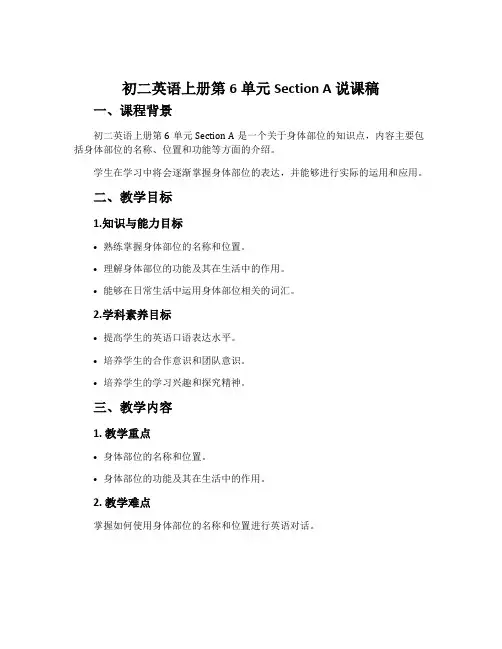
初二英语上册第6单元Section A 说课稿一、课程背景初二英语上册第6单元Section A是一个关于身体部位的知识点,内容主要包括身体部位的名称、位置和功能等方面的介绍。
学生在学习中将会逐渐掌握身体部位的表达,并能够进行实际的运用和应用。
二、教学目标1.知识与能力目标•熟练掌握身体部位的名称和位置。
•理解身体部位的功能及其在生活中的作用。
•能够在日常生活中运用身体部位相关的词汇。
2.学科素养目标•提高学生的英语口语表达水平。
•培养学生的合作意识和团队意识。
•培养学生的学习兴趣和探究精神。
三、教学内容1. 教学重点•身体部位的名称和位置。
•身体部位的功能及其在生活中的作用。
2. 教学难点掌握如何使用身体部位的名称和位置进行英语对话。
四、教学过程1. 导入环节以带图的形式呈现一个人的身体图,让学生用英语介绍这个图中的身体部位。
2. 学习过程2.1 学习材料展示介绍身体部位名称、位置以及相关的英语对话。
2.2 学习板块介绍课文中的各个部分,包括:•Listen and circle部分:学生通过听录音,标出对应的身体部位。
•Listen and number部分:学生通过听录音,标出对应的身体部位序号,并将其填在相应的括号中。
•Pair work部分:学生进行两人一组的对话练习。
2.3 学生练习学生练习时,可以使用课本自带的练习题进行练习,也可以进行对话练习。
3. 拓展活动将学生分为小组,设计口语任务,让他们进行小组合作,完成一个关于身体部位的英语表演。
4. 课堂小结通过课程的学习和实践操作,让学生进一步掌握身体部位的相关英语表达,同时培养他们的学习兴趣和英语文化素养。
五、教学反思通过本次教学,我发现学生们对身体部位的英语表达又有了更深入的了解,并且在实践中也有了更多的体验和感受。
同时,我也发现在这个过程中,学生们的英语口语表达能力得到了有效的提升,并且也有了更多的团队合作意识和学习动力。
因此,我认为在今后的教学中,应该充分挖掘学生的学习兴趣和学习习惯,充分利用各种教学资源,开展更多有意义的英语教育活动,让学生在学习中迅速提升自己的英语能力和实际运用能力。
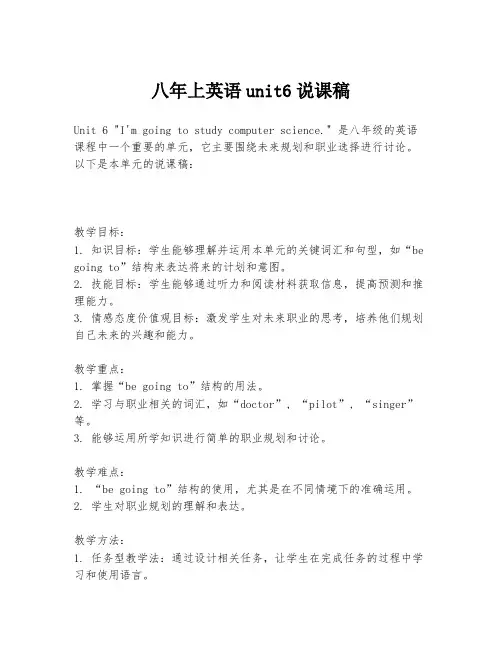
八年上英语unit6说课稿Unit 6 "I'm going to study computer science." 是八年级的英语课程中一个重要的单元,它主要围绕未来规划和职业选择进行讨论。
以下是本单元的说课稿:教学目标:1. 知识目标:学生能够理解并运用本单元的关键词汇和句型,如“be going to”结构来表达将来的计划和意图。
2. 技能目标:学生能够通过听力和阅读材料获取信息,提高预测和推理能力。
3. 情感态度价值观目标:激发学生对未来职业的思考,培养他们规划自己未来的兴趣和能力。
教学重点:1. 掌握“be going to”结构的用法。
2. 学习与职业相关的词汇,如“doctor”, “pilot”, “singer”等。
3. 能够运用所学知识进行简单的职业规划和讨论。
教学难点:1. “be going to”结构的使用,尤其是在不同情境下的准确运用。
2. 学生对职业规划的理解和表达。
教学方法:1. 任务型教学法:通过设计相关任务,让学生在完成任务的过程中学习和使用语言。
2. 合作学习:鼓励学生小组合作,共同探讨和完成学习任务。
教学过程:1. 导入(Lead-in)- 通过展示不同职业的图片,激发学生对职业的兴趣。
- 提问学生他们未来想成为什么样的人,引入“be going to”结构。
2. 呈现(Presentation)- 教授“be going to”结构的用法,并通过例句进行演示。
- 介绍与职业相关的词汇,并通过图片或实物加深学生的理解。
3. 练习(Practice)- 学生个人或小组练习使用“be going to”结构描述自己的未来计划。
- 通过角色扮演或情景对话,让学生在实际语境中运用所学知识。
4. 应用(Application)- 学生根据所学知识,完成一个关于未来职业规划的写作任务。
- 组织一个小型的职业展览会,学生可以展示自己的职业规划,并与其他同学交流。
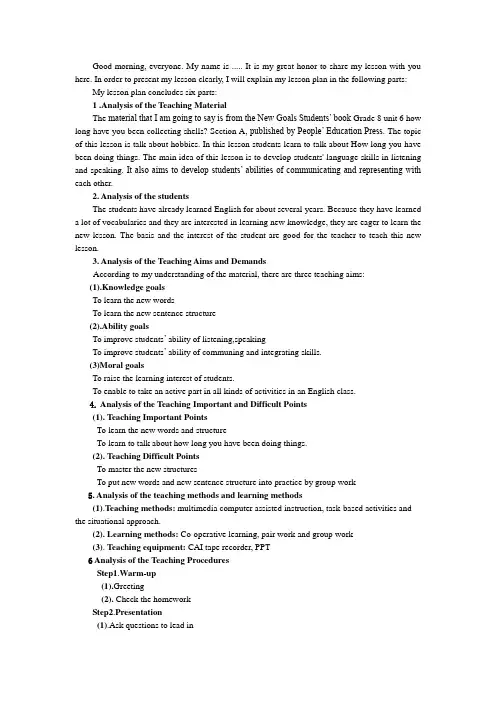
Good morning, everyone. My name is ..... It is my great honor to share my lesson with you here. In order to present my lesson clearly, I will explain my lesson plan in the following parts: My lesson plan concludes six parts:1 .Analysis of the Teaching MaterialThe material that I am going to say is from the New Goals Students’ book Grade 8 unit 6 how long have you been collecting shells? Section A, published by People’ Education Press. The topic of this lesson is talk about hobbies. In this lesson students learn to talk about How long you have been doing things. The main idea of this lesson is to develop students' language skills in listening and speaking. It also aims to develop students’ abilities of communicating and representing with each other.2. Analysis of the studentsThe students have already learned English for about several years. Because they have learned a lot of vocabularies and they are interested in learning new knowledge, they are eager to learn the new lesson. The basis and the interest of the student are good for the teacher to teach this new lesson.3. Analysis of the Teaching Aims and DemandsAccording to my understanding of the material, there are three teaching aims:(1).Knowledge goalsTo learn the new wordsTo learn the new sentence structure(2).Ability goalsTo improve students’ ability of listening,speakingTo improve students’ ability of communing and integrating skills.(3)Moral goalsTo raise the learning interest of students.To enable to take an active part in all kinds of activities in an English class.4. Analysis of the Teaching Important and Difficult Points(1). Teaching Important PointsTo learn the new words and structureTo learn to talk about how long you have been doing things.(2). Teaching Difficult PointsTo master the new structuresTo put new words and new sentence structure into practice by group work5. Analysis of the teaching methods and learning methods(1).Teaching methods: multimedia computer assisted instruction, task-based activities and the situational approach.(2).Learning methods: Co-operative learning, pair work and group work(3). Teaching equipment: CAI tape recorder, PPT6 Analysis of the Teaching ProceduresStep1.Warm-up(1).Greeting(2). Check the homeworkStep2.Presentation(1).Ask questions to lead inQ1: Do you like basketball?Q2: When do you play basketball?Q3: How long have you been playing basketball?This activity can catch the student s’ attention and make them be interested in the new lesson.(2) Check the answerAsk some students to say out their answers, and then give a big hand to the students who say out the answer. This activity can make the students be more confident in learning English, and let them learn to share others happiness by encouraging.And then, introduce the new structure how long have you been....the answer is I have been....(3).show some picturesAfter the students saying out their opinions, then let them see some pictures about some hobbies, ask them how long have they been..., and teach them use they/ I have been... sentence structure to answer the questions. This activities can make students hold a deeper understanding of the new sentence structure.(4).VocabularyUse some pictures to teach the student new words, the pictures can make the students learn the new words easier.(5). Group workLet students use the new structure to make new sentences and dialogues with several students and let them present the dialogues. This activities provide opportunities for students to role play. It can help students improve their ability of speaking English.Step3. Consolidate and SummaryLet the students write about what their said and make a summary about what their learn. It can consolidate the knowledge that the student learned.Step4. Homework(1). To practice the dialogues.(2). To make more predictionsStep5. Blackboard Writing DesignUnit 6 How long have you been collecting shells?Do you like basketball?When do you play basketball?How long have you been playing basketball?I have been .....How long have you been collecting shells。
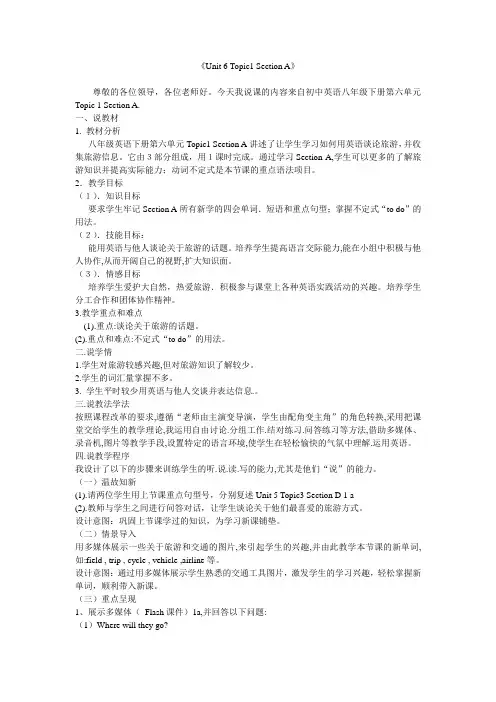
《Unit 6 Topic1 Section A》尊敬的各位领导,各位老师好。
今天我说课的内容来自初中英语八年级下册第六单元Topic 1 Section A.一、说教材1. 教材分析八年级英语下册第六单元Topic1 Section A讲述了让学生学习如何用英语谈论旅游,并收集旅游信息。
它由3部分组成,用1课时完成。
通过学习Section A,学生可以更多的了解旅游知识并提高实际能力;动词不定式是本节课的重点语法项目。
2.教学目标(1).知识目标要求学生牢记Section A所有新学的四会单词.短语和重点句型;掌握不定式“to do”的用法。
(2).技能目标:能用英语与他人谈论关于旅游的话题。
培养学生提高语言交际能力,能在小组中积极与他人协作,从而开阔自己的视野,扩大知识面。
(3).情感目标培养学生爱护大自然,热爱旅游.积极参与课堂上各种英语实践活动的兴趣。
培养学生分工合作和团体协作精神。
3.教学重点和难点(1).重点:谈论关于旅游的话题。
(2).重点和难点:不定式“to do”的用法。
二.说学情1.学生对旅游较感兴趣,但对旅游知识了解较少。
2.学生的词汇量掌握不多。
3. 学生平时较少用英语与他人交谈并表达信息.。
三.说教法学法按照课程改革的要求,遵循“老师由主演变导演,学生由配角变主角”的角色转换,采用把课堂交给学生的教学理论,我运用自由讨论.分组工作.结对练习.问答练习等方法,借助多媒体、录音机,图片等教学手段,设置特定的语言环境,使学生在轻松愉快的气氛中理解.运用英语。
四.说教学程序我设计了以下的步骤来训练学生的听.说.读.写的能力,尤其是他们“说”的能力。
(一)温故知新(1).请两位学生用上节课重点句型号,分别复述Unit 5 Topic3 Section D 1 a(2).教师与学生之间进行问答对话,让学生谈论关于他们最喜爱的旅游方式。
设计意图:巩固上节课学过的知识,为学习新课铺垫。
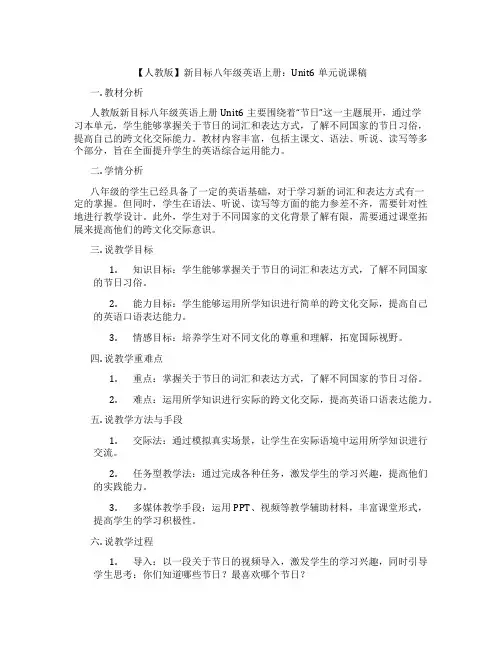
【人教版】新目标八年级英语上册:Unit6单元说课稿一. 教材分析人教版新目标八年级英语上册Unit6主要围绕着“节日”这一主题展开,通过学习本单元,学生能够掌握关于节日的词汇和表达方式,了解不同国家的节日习俗,提高自己的跨文化交际能力。
教材内容丰富,包括主课文、语法、听说、读写等多个部分,旨在全面提升学生的英语综合运用能力。
二. 学情分析八年级的学生已经具备了一定的英语基础,对于学习新的词汇和表达方式有一定的掌握。
但同时,学生在语法、听说、读写等方面的能力参差不齐,需要针对性地进行教学设计。
此外,学生对于不同国家的文化背景了解有限,需要通过课堂拓展来提高他们的跨文化交际意识。
三. 说教学目标1.知识目标:学生能够掌握关于节日的词汇和表达方式,了解不同国家的节日习俗。
2.能力目标:学生能够运用所学知识进行简单的跨文化交际,提高自己的英语口语表达能力。
3.情感目标:培养学生对不同文化的尊重和理解,拓宽国际视野。
四. 说教学重难点1.重点:掌握关于节日的词汇和表达方式,了解不同国家的节日习俗。
2.难点:运用所学知识进行实际的跨文化交际,提高英语口语表达能力。
五. 说教学方法与手段1.交际法:通过模拟真实场景,让学生在实际语境中运用所学知识进行交流。
2.任务型教学法:通过完成各种任务,激发学生的学习兴趣,提高他们的实践能力。
3.多媒体教学手段:运用PPT、视频等教学辅助材料,丰富课堂形式,提高学生的学习积极性。
六. 说教学过程1.导入:以一段关于节日的视频导入,激发学生的学习兴趣,同时引导学生思考:你们知道哪些节日?最喜欢哪个节日?2.新课呈现:通过PPT展示本节课的主要内容,包括节日词汇和表达方式,不同国家的节日习俗等。
3.课堂实践:模拟真实场景,让学生分组进行角色扮演,运用所学知识进行跨文化交际。
4.语法讲解:针对本节课的语法点,进行详细的讲解和示例,让学生在理解的基础上进行运用。
5.听力训练:播放一段关于节日的听力材料,学生听后进行问答,检查学生对听力材料的理解程度。
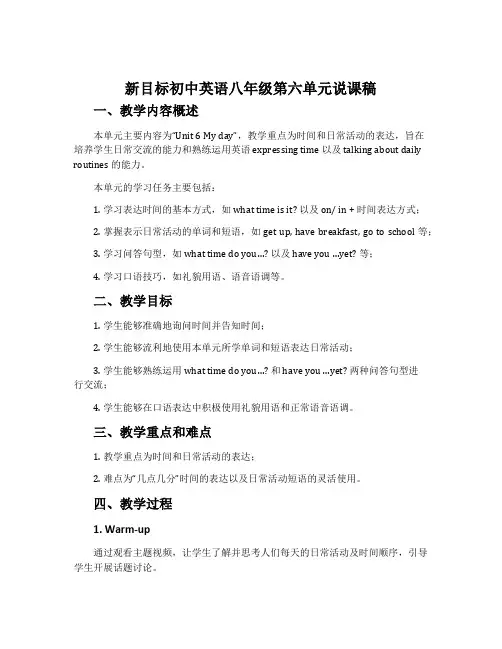
新目标初中英语八年级第六单元说课稿一、教学内容概述本单元主要内容为“Unit 6 My day”,教学重点为时间和日常活动的表达,旨在培养学生日常交流的能力和熟练运用英语 expressing time 以及 talking about daily routines 的能力。
本单元的学习任务主要包括:1.学习表达时间的基本方式,如 what time is it? 以及 on/ in + 时间表达方式;2.掌握表示日常活动的单词和短语,如 get up, have breakfast, go to school 等;3.学习问答句型,如what time do you…? 以及have you …yet? 等;4.学习口语技巧,如礼貌用语、语音语调等。
二、教学目标1.学生能够准确地询问时间并告知时间;2.学生能够流利地使用本单元所学单词和短语表达日常活动;3.学生能够熟练运用what time do you…? 和have you …yet? 两种问答句型进行交流;4.学生能够在口语表达中积极使用礼貌用语和正常语音语调。
三、教学重点和难点1.教学重点为时间和日常活动的表达;2.难点为“几点几分”时间的表达以及日常活动短语的灵活使用。
四、教学过程1. Warm-up通过观看主题视频,让学生了解并思考人们每天的日常活动及时间顺序,引导学生开展话题讨论。
2. Presentation通过图片、音频、视频等多种媒体语言让学生掌握时间和日常活动的表达方式,培养学生口语表达能力。
3. Practice1.针对时间问答部分,设计所需问题进行练习;2.针对日常活动,设计所需情景进行问答练习,如“请对方告知自己最近的日常生活”等。
4. Consolidation通过作业练习巩固本单元所学知识。
5. Extension1.针对本单元所学内容,设计生活实践任务;2.设计游戏、竞赛、角色扮演等多种形式的课堂活动,激发学生学习兴趣。
八下u6英语说课稿在准备八年级下册第六单元的英语说课稿时,我们首先要明确本单元的教学目标、教学内容、教学方法以及教学过程。
以下是一份详细的说课稿:教学目标:1. 知识与技能:学生能够掌握本单元的核心词汇和语法结构,理解并运用相关表达。
2. 过程与方法:通过多种教学活动,培养学生的听说读写能力,尤其是口语交际能力。
3. 情感态度与价值观:激发学生学习英语的兴趣,培养跨文化交流意识。
教学内容:1. 词汇:包括本单元出现的重点词汇和短语。
2. 语法:本单元的语法重点,如时态、语态等。
3. 阅读:理解并分析本单元的阅读材料。
4. 口语:通过对话和讨论,提高学生的口语表达能力。
教学方法:1. 任务型教学法:通过完成具体的任务来学习语言。
2. 合作学习:鼓励学生小组合作,共同解决问题。
3. 情景教学:创设真实或模拟的情景,让学生在语境中学习语言。
教学过程:1. 导入(Warm-up)- 通过提问或展示图片,激发学生对本单元主题的兴趣。
2. 呈现(Presentation)- 介绍新词汇和语法结构,通过例句和解释帮助学生理解。
3. 练习(Practice)- 通过填空、转换句型、角色扮演等活动,让学生实践新学的语言点。
4. 应用(Application)- 学生通过小组讨论、情景对话等方式,将所学知识应用到实际交流中。
5. 产出(Production)- 学生完成一项综合性任务,如编写短文、进行口头报告等,展示学习成果。
6. 小结(Summary)- 回顾本节课的重点内容,强调易错点。
7. 作业(Homework)- 布置相关的练习题和阅读材料,巩固课堂所学。
教学评价:- 通过课堂表现、作业完成情况和口语测试等方式,对学生的学习效果进行评价。
教学反思:- 课后,教师应反思教学方法的有效性,学生的反应,以及教学过程中可能存在的问题,以便不断改进教学。
请注意,这只是一个说课稿的模板,具体内容需要根据实际教学情况和学生需求进行调整。
初二英语上册第6单元 Section A 说课稿一、教材分析本单元主要讲述了关于节日和活动的话题,通过学习了解了节日的起源、庆祝活动以及人们参与活动的方式。
本单元的教学旨在提高学生的英语听、说、读、写能力,帮助他们学会谈论自己最喜欢的节日,分享活动的体验,以及提供建议和邀请他人参加活动。
二、教学目标1.通过听说读写的活动,培养学生的英语交际能力,让他们能够用英语描述节日和活动。
2.培养学生的阅读理解能力,通过阅读文章了解不同节日的起源和庆祝方式。
3.提高学生的写作能力,让他们能够用英语写一篇关于自己最喜欢的节日的文章。
4.培养学生合作学习的意识和能力,通过小组活动促进学生之间的合作与交流。
三、教学重点1.学习并掌握重要词汇和短语,如festival, celebration, decorate, enjoy等。
2.学习并能理解关于节日和活动的听力材料,如听取他人对节日的描述,以及询问他人对活动的意见。
3.通过阅读文章,了解不同节日的起源和庆祝方式。
四、教学难点1.比较和对比不同节日的庆祝方式。
2.提供建议和邀请他人参加活动的表达方式。
五、教学方法与学时安排本单元的教学将采用任务型教学法和合作学习法相结合的方法来进行。
教学安排如下:•第一课时:学习并掌握重要词汇和短语,进行听力训练,培养学生的听说能力。
•第二课时:阅读掌握单元中的文章,通过阅读理解活动提高学生的阅读能力。
•第三课时:学习如何描述自己最喜欢的节日,进行听说训练,培养学生的口语表达能力。
•第四课时:进行写作训练,让学生用英语写一篇关于自己最喜欢的节日的文章。
•第五课时:小组合作活动,让学生在小组中讨论并向其他小组提出建议和邀请参加活动。
六、教学资源准备1.PowerPoint 简介介绍节日和活动的图片和文字资料。
2.单元课文的复印件或投影仪投影片。
3.学生用书和练习册。
4.小组合作活动所需的讨论纸和笔。
七、教学步骤第一课时1.导入新课,用图片展示一些节日和庆祝活动的图片,引导学生谈论他们对这些节日的了解和想法。
人教版英语八年级上第6单元英文说课稿Unit 6 It’s raining!Page 35 Section B 3a~4Good morning, everyone. I’m glad to stand here to share my ideas about the lesson with you. I hope that you will give me some advice for my presentation. I will analyze the lesson from the six aspects:analysis of teaching material, studentanalysis, teaching methods, learning methods, procedures and blackboard design. Part One :Analysis of teaching material1 .Status And FunctionThis unit focus on a very interesting topic—Will people have robots? it can raiselearning interest of students and it’s also helpful to improvetheir spoken English.2. Teaching Aims and Demandsnowledge Objects: K(1)The first one, students can listen, read, say and spell the new words and phrases.(2) The second one is to know the usage of some phrases.Avility Objects(1)To improve the ability of getting information by reading.(2)To develope the ability of speaking and writing, and the abilityof working in groups and communication..Moral Object :3. Teaching Key Points1(To help Ss communicate with each other using the new sentence pattern.2(To enable Ss to study in groups and co-operate skillfully.3. To develop Ss’interest in English. I think, it’s the most important .4.Teaching DifficultiesI think the most difficult point is to make sure the Ss use the sentence pattern correctly and to finish the task by themselves.Part Two Analysis of studentsSs have learned the Present Progressive Tense in the last unit. They can understand some words and some simple sentences. And ,this lesson are about weather and what people usually do in the different weather. It’s related to our daily life,so Ss must havetaken a great interest in this lesson now.Part Three Teaching methodsIn this topic,I will use Task-based Method, Communicative Method, Group Co-operate method. I think if I want to improve the students’ oral English,I should give them enough chances to practice and I will use pair work,group work to let the students take an active part in all kinds of activities.That is “Learning bydoing,learning by using”.Part Four Teaching ProceduresStep 1 Lead-inThe purpose is to arouse the students’ interest of study. I’lltalk about dreams with students for minutes. What jobs do you want to have in the future? A doctor or an actor? Maybe some boys want to be soldiers? Do you want to work as a journalist? OK, if you are a journalist and you want to give a report, how can you express yourself clearly? Now there is a report on our book, please turn to Page 35.Step2 PresentationFirst let’s look at the new words. Show the new words of Page 35 on the screen. Read them and students repeat. At the same time, talk about the Chinese meaning together.Step3 3a1.Now turn to Page 35.Look at 3a. This is a report. Yuan Yuan is reporting for CCTV’s Around The World show. She talks about the things from several aspects. Ask students to read the report loudly and I’ll divide the students into groups of 4people. Talk about the questions on the blackboard with their partner. Write the questions on the blackboard. Thanks:(what does she thank for?) When:(when does the thing happened?)Where:(where is it?) Weather:(what’s the weather like?) Who:(whoare there?) Why:(why are they there?) What:(what are they doing?)su rprised: (what are they surprised for?)summary:(what’s the summary of the report?)In a while, ask the presenter of each group answer the questions. W rite the best answer on the blackboard. The purpose is to develop the skills of skimming and how to gain the different information of the articles. And their ability of co-operation will be well trained.2.Then go back to the question in the title. Underline the things that people are doing. Circle the words that describe the weather.We’ll do the job on th e blackboardtogether.3.Next we read the report carefully and talk about the grammarpoints in it. Show the grammar points on the screen. By this way, students can comprehensive the article better. And it’s also helpful to improve the writing skills of students.Step4 3bLook at the pictures of France. Encourage students to describe the pictures by themselves. Don’t be worried about making mistakes. Ask several students to show their description to the whole class. The purpose is to improve students’ o ral English.Then fill in the blanks. Try to finish it by themselves. Check the answer on the blackboard . Read the article and translate it for the whole class at last.tep5 Survey SIn this part, I’ll ask students to practice the conversation in pairs. Ask your classmates what they do in different kinds of weather. Make a list.eg. A: What do you usually do when it’s raining?B: I usually read a book.A: What do you usually do when it’s sunny?B: I usually swim in a river.By this way, students can get enough chance to practice their oral English and develop students’ interest of English.Step6 SummaryDuring my teaching,I’ll try my best to get my class alive and encourage the studentsto talk with each other in English.I think the general aim of English teaching is to improve the ability of using English. And I’ll teach students the writing skills in a lively way. Make the students to love the interesting English and the lovely English teacher.Part7 HomeworkRecite the article of 3a and write an article about what the weather is like in your hometown and what the people are doing.。
初二英语上册unit6说课稿Unit 6 说课稿尊敬的各位老师,大家好。
今天,我将就初二英语上册的第六单元进行说课。
本单元的主题是“购物”,旨在通过与购物相关的语言点和活动,提高学生的英语交际能力。
一、教学目标1. 知识目标:学生能够掌握购物相关的词汇,如“size”, “color”, “price”, “discount”等,并能够使用这些词汇进行基本的购物对话。
2. 能力目标:通过模拟购物场景,学生能够运用所学词汇和句型进行实际的购物交流。
3. 情感目标:培养学生的购物礼仪和消费观念,理解并实践公平交易和诚信购物。
二、教学重点1. 购物相关的词汇和表达方式。
2. 如何询问物品的价格、颜色、尺寸等信息。
3. 表达购买意愿和拒绝购买的礼貌用语。
三、教学难点1. 学生能够灵活运用购物相关的句型进行交流。
2. 理解并运用购物时的礼貌用语和交际技巧。
四、教学方法1. 情景教学法:通过模拟购物场景,让学生在实际情境中学习和使用语言。
2. 合作学习法:鼓励学生分组合作,通过角色扮演等形式,共同完成购物任务。
3. 任务型教学法:设置具体的购物任务,让学生在完成任务的过程中学习和运用语言。
五、教学过程1. 导入(Lead-in):- 通过展示一些购物图片或视频,激发学生对购物话题的兴趣。
- 简单讨论学生平时的购物经历,引导学生思考购物时可能用到的英语表达。
2. 呈现(Presentation):- 教授购物相关的词汇和句型,如“Can I help you?”, “What size/color do you want?”, “How much is it?”等。
- 通过图片或实物,帮助学生直观理解词汇。
3. 练习(Practice):- 学生两人一组,进行角色扮演练习,模拟购物对话。
- 教师提供一些购物场景,让学生用所学句型进行对话。
4. 应用(Application):- 组织一个模拟购物活动,学生需要使用英语完成购物任务。
Unit 6 I’m going to study computer science.课题:period 1课型:新授课主备:慕萌审核:赵雪梅教学班级:教学时间:Ⅰ、【教学目标】:1、知识与能力目标:(1). 1. 口、笔头掌握以下句型:A: What do you want to be when you grow up ? B:I’m going to be a comp uter programmer.A :How are you going to do that ?B :I’m going to study computer science.A: What does Cheng Han want to be? B :He wants to be…(2).熟练掌握以下词汇:grow up, computer programmer, cook, doctor, engineer, violinist, driver, pilot, pianist, scientist2、情感目标:通过谈论将来的计划打算和怎样实现这一目标,引导学生思考自己的人生目标,及早为将来做准备,树立正确的人生观。
3、过程与方法采用practicing, listening, saying and role playing 等多种策略,利用图片和游戏积极开展pair work等活动。
Ⅱ、【教学重难点】:正确使用when 引导的时间状语从句,并能用be going to 结构对将来的事做出计划。
Ⅲ、【教学方法】感知---合作探究---互动---发现---训练---反思Ⅳ、【教学课时】一课时Ⅴ、【教学步骤】【教前准备---感知】:一、你熟悉下列人物吗?通过学习,试着写出他们职业的英文表达方式。
Yang Liwei:_____________ Jackie Chen:______________Jay Chou: _____________ Yao Ming: ______________二、回忆并写出我们学过的有关职业的英文表达方式:___________________________________三、你知道更多的职业的英文表达方式吗?查资料写下来与同伴分享吧(可参考41页的1a)四、认读并书写本课单词1.个人自读,记忆单词.2.小组互相检查读、写情况.3 .写出下列单词并展示医生工程师小提琴手司机飞行员钢琴家科学家厨师学院4.在小组内核对答案.5.根据自己对各种职业的兴趣,将1a 的单词排序。
【疑难摘录---发现】【合作探究---互动】一–What do you want to be when you grow up? –I want to be a computer programmer.在以上两句话中,want 后跟动词的哪种形式做宾语?_______ 即:___________(想要做某事)。
二、–How are you going to do that? - I’m going to study computer science.仔细观察上面两句话,他们都含有那种结构?这种结构表达什么含义。
“be going to+______”表示________(过去/现在/将要)发生的事或打算、计划、决定三、翻译下面句子:1)当你长大后你打算成为什么?_____________________________________2)我打算成为一名演员。
_____________________________________ 【达标测试---训练】单项选择。
1.---What’s your brother going to______when he________up? ----A soldier.A. do; grow B have ; grows C. be ; grows D . play ; grow2. Her father is an ____________in a big factory.A. starB. engineerC. workerD. player3. - are you going to be a pianist in the future ?-I’m going to practiceplaying the piano every day.A. What B .When C. How D. Why4. There an art exhibition this Sunday.A. haveB. is going to haveC. is going to beD. is going to hold5 He is going to to New York with his parents.A. takeB. moveC. bringD. stay【拓展延伸---中考链接】(2010庆阳市)1. He is going to take guitar lessons every day(改为一般疑问句)he going to guitar lessons every day ? (2005北京西城)2. Mom is going to do some shopping this afternoon(对划线部分提问)is Mom going to this afternoon?【错题集合】【教后反思】1. 描述未来的打算,可以用什么结构?_______________________________其后跟动词的什么形式?________________________________________2. 本节课你又学到了那些职业名称?_________________________________3. 你能用英语询问你朋友未来的打算吗?请写出来吧!_________________Unit 6 I’m going to study computer science.课题:period 2课型:新授课主备:慕萌审核:赵雪梅教学班级:教学时间:Ⅰ、【教学目标】:1、知识与能力目标:(1)口、笔头掌握以下句型:I know why you’re so good at writing stories.How are you going to become a writer.I’m going to keep on writing stories.Just make sure you try your best.(2)熟练掌握以下词汇: be sure about, make sure, college, education, university, article, send等(3)掌握并能正确使用本课时的重点短语和结构:want to do sth, be going to do sth, be good at, keep on doing sth, make sure, try one’s best to do sth.2、情感目标:引导学生理解要实现人生理想并不容易,要付出很多努力。
3、过程与方法采用practicing, listening, saying and role playing 等多种策略,利用图片和游戏积极开展里listioning,pair work等活动。
Ⅱ、【教学重难点】:(1)学习有关职业的单词。
(2)学会谈论自己或他人的理想和以及谈论实现理想的方式。
Ⅲ、【教学方法】感知---合作探究---互动---发现---训练---反思Ⅳ、【教学课时】一课时Ⅴ、【教学步骤】【教前准备---感知】:一、读记单词1. cook 厨师;烹饪;煮2. doctor 医生3. engineer 工程师4. violinist 小提琴手5. driver 驾驶员;司机6. pilot 飞行员7. pianist 钢琴家8. scientist 科学家9. college 学院;大学;高等专科学校二、按要求写出下列单词或短语学习电脑科技练习篮球刻苦学习数学上表演课长大电脑编程师三、你对自己的未来有一个初步打算吗?想一想,填写下表,准备上课时交流。
What I’m going to beWhereHow【疑难摘录---发现】【合作探究---互动】一、对话中be good at…的意思是_______________, =______________ ;ke ep on 后跟_____________(动词原形/动词ing形式/动词不定式),意思是___________;Just makesure you try your best;make sure意思是______________; try one’s best (to do sth)意思是______________二、信息整合:1. .听录音,圈出2a中表示程晗的理想的图片。
2. 听录音,完成2b的表格。
三、口语技能:两人一组,利用上面的俱乐部来练习下面的对话。
A: What does Cheng Han want to be?B: He wants to be….A: How is he going to do that?四、阅读寻找2d中的考点be going to+动词原形be going to的基本用法be going to是"一般将来时"的一种表现形式,表示将来某个时间将要发生的动作或存在的状态,意思为"打算,将要"。
其中"be"会根据主语的人称变化成"is,am,are"等形式。
"to"是"不定式符号",跟在它后面的动词必须是动词原形。
在肯定句中,be going to模样是:主语+be(am / is / are) + going to +动词原形+其它。
如:I am going to work hard this term.我打算这学期努力学习。
否定句要在be的后面加not.I am not going to play football.我不打算踢足球。
We are going to have a class meeting this afternoon.今天下午我们打算开班会。
(安排)Look at the black clouds. It's going to rain.看那些乌云,快要下雨了。
(推测)【达标测试---训练】1.他打算学习教育。
He going education.2.我的表弟想成为一名厨师。
My cousin a cook.3.Mary打算去上表演课。